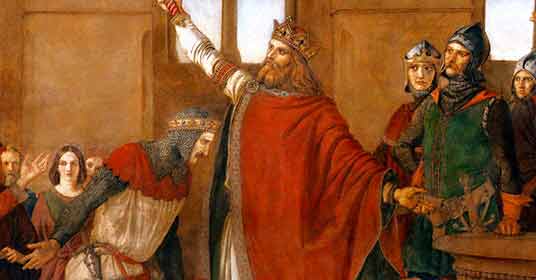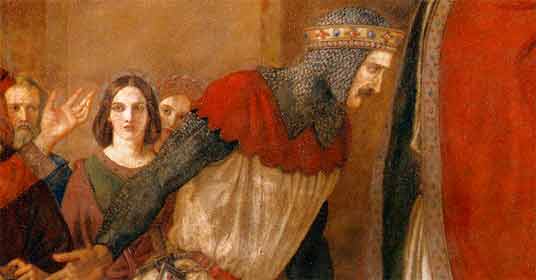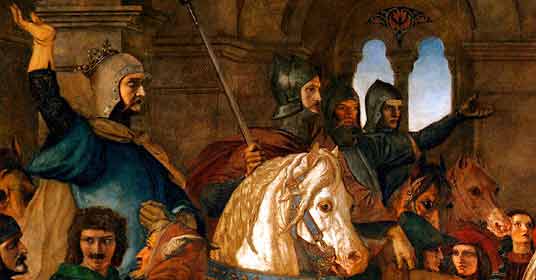Hospitality - The Admission of Sir Tristram to the Fellowship of the Round Table
© 2007
Armchair Travel Co. Ltd. - This page may be used for non-commercial purposes
ONLY!
![]()

[ Play
Narrated and Animated Movie ! ] Sir Tristram, after many adventures, was brought to the court of King Arthur. The scene that followed is used here to represent the chivalric virtue of Hospitality.
'Then King Arthur took Sir Tristram by the hand and went to the Table Round. Then came Queen Guenever and many ladies with her, and all the ladies said at one voice: 'Welcome, Sir Tristram.'
This fresco, entitled Hospitality, is the largest of the five which William Dyce planned for this room. It was unfinished at the artist's death in 1864, and was finished by C W Cope. The chivalrous knight, Sir Tristram, stands on the steps before the King, who raises his sword in welcome.
Behind Sir Tristram, the mounted figures of Sir Launcelot, who had just fought Tristram unknowingly, and Sir Gawaine and Sir Gaheris, whom Launcelot and Tristram had met as they returned to Camelot. The ladies of the court raise their hands and their voices in greeting, and a harper and two small boys make music. Behind King Arthur you can just see the edge of the Round Table, with knights standing to applaud. In a moment the King was to walk around it, looking for a seat to award to Sir Tristram.
Dyce's original design for this, the largest of the wall compartments in the Queen's Robing Room was for 'Piety: The Departure of the Knights of the Round Table on the Quest for the Holy Grail.' The original watercolour survives. It was not accepted by the Fine Arts Commission.
The five frescoes in the Robing Room represent the chief virtues of Chivalry: Courtesy, Mercy, Religion, Generosity and Hospitality. Dyce was actually commissioned to produce seven frescoes and seven friezes in the room, for the sum of £800 per year. The Arthurian tales - chiefly in the 15th-century version by Sir Thomas Malory - had long been recognised as a founding heroic myth of the British nation and as such, were felt to have an important place in the decoration of the new Palace of Westminster.
The actual historical period to which Arthur would have belonged is from late-fifth to early sixth centuries AD - that is, around 475 to 511 or 539 AD - and he and his so-called 'knights' would probably have worn arms and clothes of the late Roman Empire.
However, the tales have come down to us in medieval guise, largely through the version by the 15th-century Sir Thomas Malory, and even today, when we really know better, we see Arthur and his knights in full medieval dress: chain mail, helmets, saddles and stirrups (the last of which had yet to appear in Arthur's day) .
Dyce shows several figures wearing chain mail. It is unlikely that such armour was known in the time of the historical Arthur; but since chain mail is the earliest form of armour in these islands, the decision was taken to depict the Arthurian knights as wearing it. But Dyce complained bitterly about the time it took to paint it - he claimed it seriously delayed the completion of the work.
Progress was in any case painfully slow, and on the 30th of May 1854 Dyce asked to be granted 'exclusive possession' of the Robing Room. The request was passed on by the Secretary of the Fine Arts Commission to the Queen:
The Commissioners humbly pray that Her Majesty will be pleased, on the occasion of the Opening or Prorogation of Parliament, to give up the use of the Robing Room.
The Queen consented, and for the next few years the Robing Room became, effectively, Dyce's studio - in fact he gave it as his address. But during these years he took more and more outside work, and little progress was made on these frescoes.
Another cause of delay was the fact that he could only paint in the summer, since the frescoes (being painted directly onto wet plaster) took much too long to dry during the winter months.
[ Virtual
Tour ] [ Main Topics
Index ]
-
'Welcome,' said Arthur, 'for one of the best knights and the gentlest of the world, the man of most worship, ye are welcome to this court.'
- Malory





Additional Information on
Hospitality - The Admission of Sir Tristram to the Fellowship of the Round Table
- Sir Charles Eastlake
Explore-Parliament.net: Advanced Category Search
Keyword Categories:
_Topic_Arthur_Legend
_Event_Literary
_Object_Painting
_Object_Artwork
_Artist_Dyce
_Hospitality